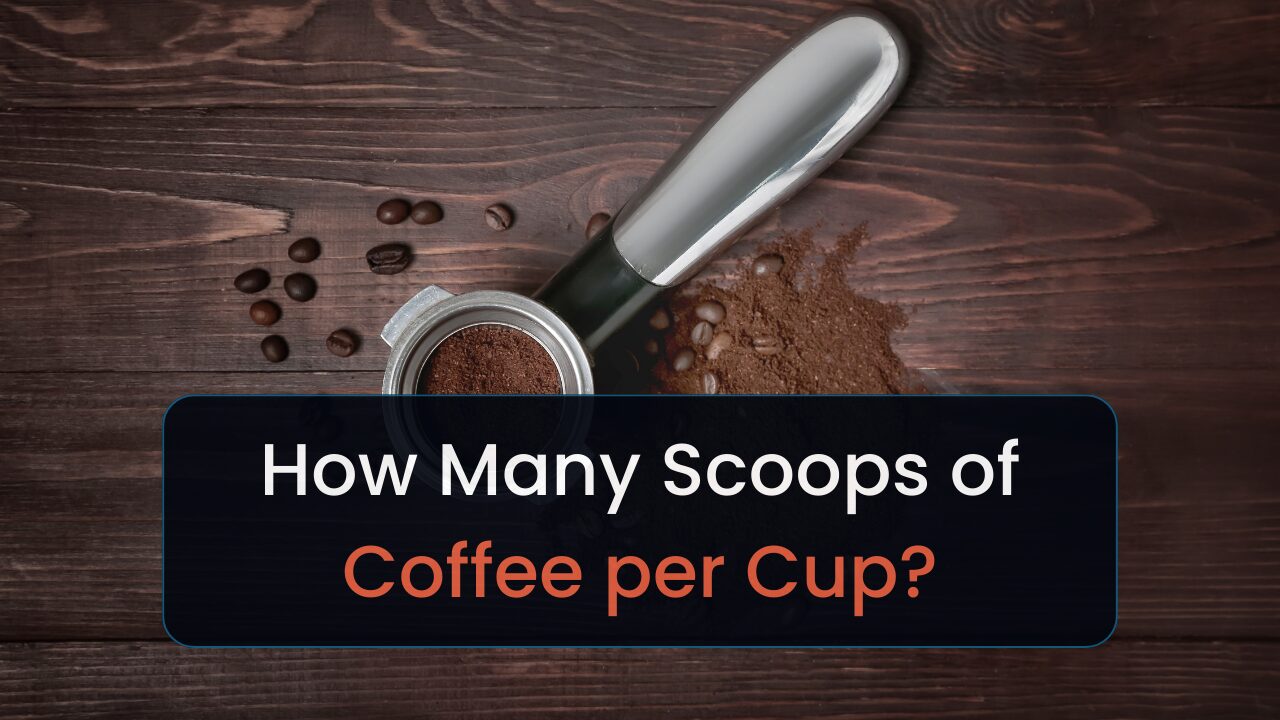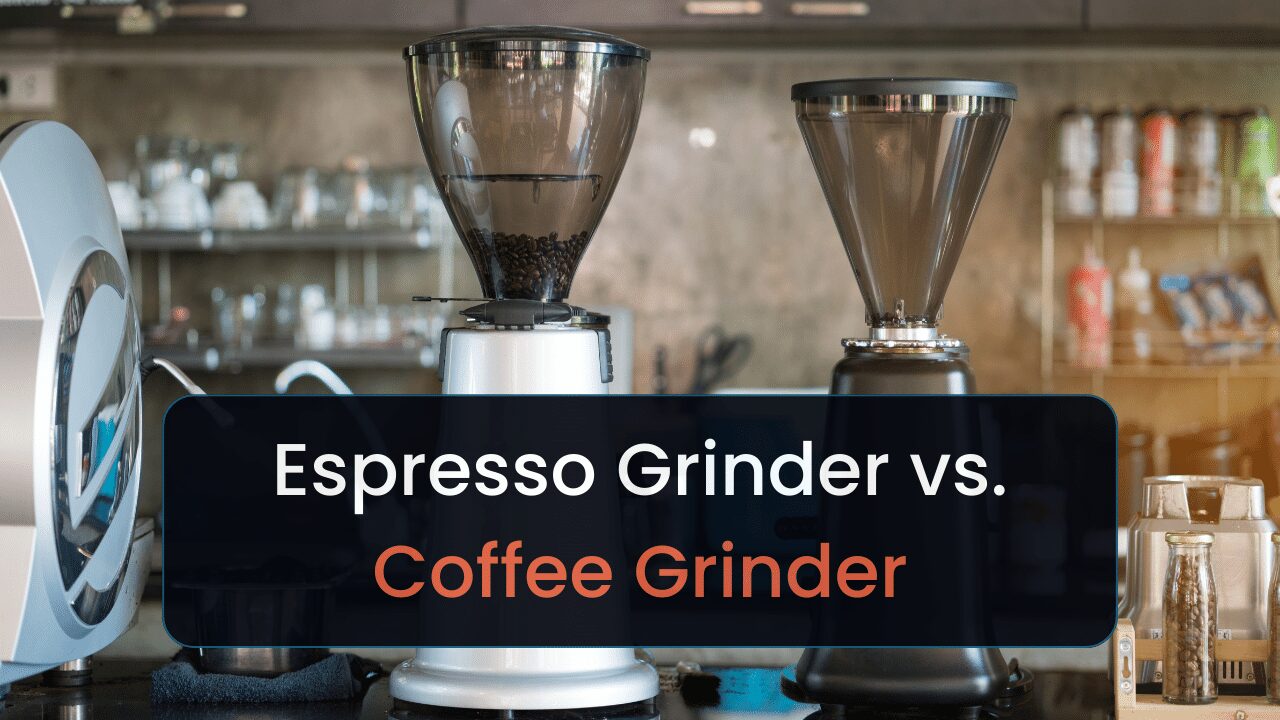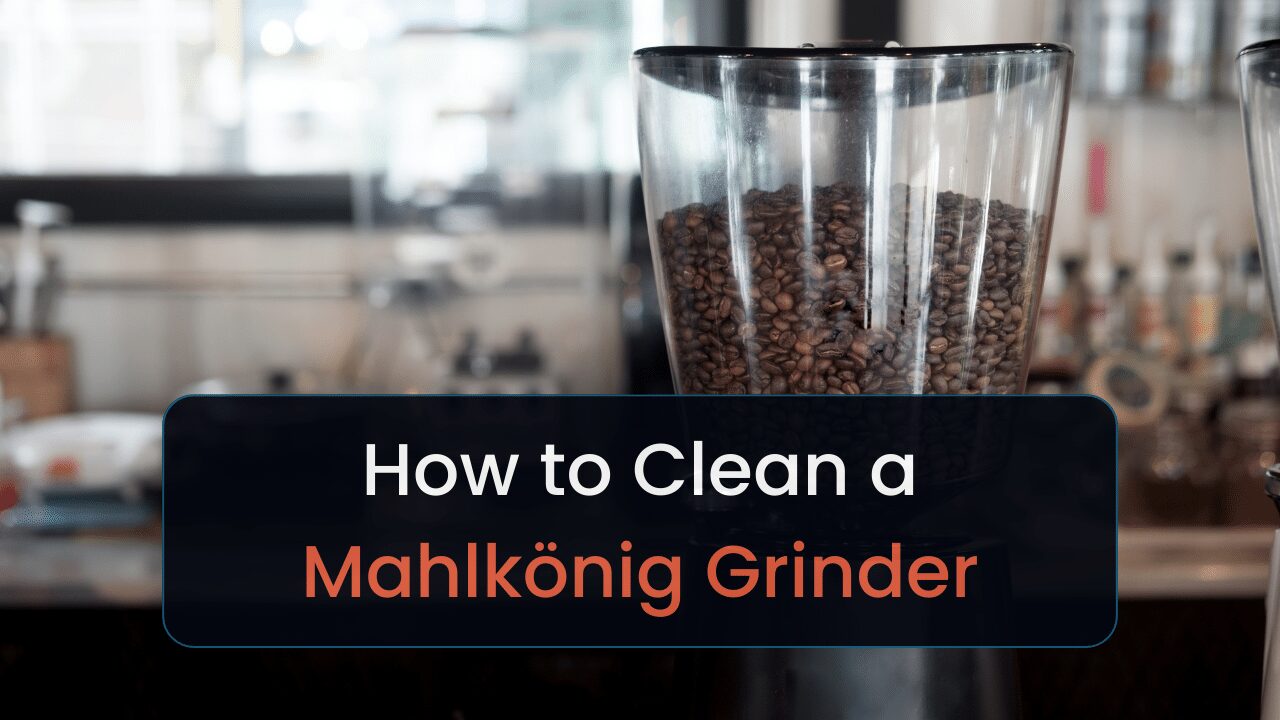Love to make French press coffee? These are the best coffee grinders for preparing it.
French press requires a coarse grind so I’ve been examining the best coffee grinders that do just that.
And with my research concluded, I’ve chosen the Fellow Ode as my top pick. I’m crazy about this grinder because of its ability to make all kinds of coffee for a great price.
Fellow Opus: Best Overall
- Price: $$$
- Grind quality: Very adaptable but not super fine
- Capacity: 110 g
- Burr info: 40 mm conical, stainless steel
- Best for: All levels, but not super pros
- Best for coffee type:
- Espresso, pour-over, filter coffee, Aeropress, French press, moka pot, cold brew
- Warranty: 1 year
But that price might not be great for you. Or, you might have some other criteria that you want to meet. So I’ve picked ten more than you could love.
Let’s find out about them.
9+ Best French Press Coffee Grinders
- Best overall: Fellow Opus
- Best premium model: Monolith Titan
- Best for under $100/best budget option: Cuisinart Supreme Grind Automatic
- Best for under $50/strictest budget option: Hamilton Beach
- Best blade grinder: De’Longhi KG49
- Best manual grinder: 1Zpresso JX-Pro-S
- Best budget manual grinder: Timemore Chestnut C2
- Best for Canada: Baratza Encore
- Best for UK and Europe: Fellow Ode Gen 2
- Best for Australia: Breville Smart Grinder Pro
The Top Coffee Grinders for French Press
In this section, I’ll tell you a little more about my top 11.
#1 Best Overall – Fellow Opus
![9+ Best Coffee Grinders For French Press in [currentyear] 1 fellow opus coffee grinder](https://timscoffee.com/wp-content/uploads/2023/06/fellow-opus-coffee-grinder.png)
| Price | $$$ |
| Grind quality | Very adaptable but not super fine |
| Capacity | 110 g |
| Burr info | 40 mm conical, stainless steel |
| Best for | All levels, but not super pros |
| Best for coffee type | French press, espresso, pour over, filter coffee, Aeropress, moka pot, cold brew |
| Warranty | 1 year |
Pros
- Great build quality
- Very adaptable settings
Cons
- Not perfect for espresso
- A little small
My favorite coffee grinder on the market right now is the Fellow Opus. I think it’s fantastically affordable but still of a very high quality. And one of its specialities is a French press grind.
You’ll be able to make a great cup of French press with the highly adaptable settings but if you want a change from that, it’s easy to do. Just press a few buttons and you’ll be making a good cup of drip coffee or espresso in no time.
The 40 mm conical burrs aren’t the perfect option for the finest blends but they’ll still do a fair job and coarse grinds are going to be no problem at all.
Because of this, however, I wouldn’t recommend the Fellow Opus for any pro baristas out there but it’s going to be more than enough for any home users.
The hardware itself of this grinder is very good as well. It’s compact and put together nicely with good materials. One key benefit of this is that it’s quiet when grinding.
Because of the compact design, the bean hopper is a little small at 110 g. But that’s still enough for 10+ cups of coffee in one grind.
If you’re based at home and want to make a good cup of French press coffee, this is my top recommendation for you. It proves that you don’t have to break the bank to get good coffee effectively, quietly and easily.
#2 Best Premium Model – Monolith Titan
![9+ Best Coffee Grinders For French Press in [currentyear] 2 monolith titan](https://timscoffee.com/wp-content/uploads/2023/06/monolith-titan.png)
| Price | $$$$$ |
| Grind quality | Exceptional at all levels |
| Capacity | 40 g |
| Burr info | 75 mm flat, Titanium-Nitride coated stainless steel |
| Best for | Professionals |
| Best for coffee type | French press, espresso, pour over, filter coffee, Aeropress, moka pot, cold brew, Turkish |
| Warranty | 5 years |
Pros
- Extra long warranty
- Perfect control for all coffee types
Cons
- Small bean hopper
- Could be seen as excessive
At the upper end of the product spectrum, I present to you the Monolith Titan. This professional grade coffee grinder is very expensive but it is a phenomenal piece of machinery.
Of course, it’s fantastic for French press coffee. You can change the settings to allow the 75 mm flat burrs to grind slowly and for a lesser duration. This means they’ll grind coarse and unevenly, the perfect combination for French press coffee.
If you want a break from French press and filter coffee, you can send the settings the other way to make a perfect cup of espresso or aeropress if you like, for example.
I also like the fact that you’ll get some five years of warranty with the Titan instead of the standard one. It shows that Monolith knows how durable this grinder will be.
The bean hopper is very small at 40 g though. Don’t expect to be able to make more than 3 or 4 cups of coffee from a single grind here.
In fact, this is the only real downside to the Monolith Titan unless you consider the fact that it might be a little excessive for just French press coffee. You’d only really want to buy this thing if you like to make all types of coffee.
And even then, the Titan is better suited to the pros or advanced home users. I wouldn’t recommend this to beginners.
Nonetheless, if you are a keen coffee maker with a budget to match and you want to make a lot of coffee, the Monolith Titan is my best pick.
#3 Best Under $100/Best Budget Option – Cuisinart Supreme Grind Automatic
![9+ Best Coffee Grinders For French Press in [currentyear] 3 cuisinart supreme grind automic](https://timscoffee.com/wp-content/uploads/2023/06/cuisinart-supreme-grind-automic.png)
| Price | $$ |
| Grind quality | Fair for medium and coarse grind |
| Capacity | 225 g |
| Burr info | N/A conical, stainless steel |
| Best for | Beginners |
| Best for coffee type | French press, filter coffee, moka pot, cold brew, drip coffee |
| Warranty | 18 months |
Pros
- Fantastic value French press grinder
- Affordible
Cons
- Vibrates a lot
- Plastic feels flimsy
You don’t have to spend a fortune for French press coffee of course. The Cuisinart Supreme Grind Automatic is here to prove that.
In the US, you can pick one of these up for under $100 and for that price, there’s quite a lot to enjoy.
For a start, it’s a really good option for French press coffee (as you might have expected by finding it in this article!). I found that it makes light work of medium or coarse grinds, meaning it’d be good for the likes of moka pot and drip coffee as well.
It achieves this by using its stainless steel, conical burrs to grind nice and unevenly, but of course that’s no good for espresso and such.
I like the large 225 g bean hopper as this enables over 20 cups of coffee, or quite a lot of French press-fulls.
But there are a couple of downsides when you go with the budget option. The overall build quality feels quite poor, like it could break any minute (although it probably won’t, and you get 18 months of warranty to protect you against that too).
The poor build quality is also reflected in the noise of the Supreme Grind. It’s not going to be a good option for those living with easily awoken housemates or family members.
But really these are small prices to pay to get a good French press coffee grinder for a good price. I’d recommend it to any French press home users, but it’s probably better suited to beginners instead of more experienced coffee fans.
#4 Best Under $50/Strictest Budget Option – Hamilton Beach Coffee Grinder
![9+ Best Coffee Grinders For French Press in [currentyear] 4 hamilton beach blade grinder](https://timscoffee.com/wp-content/uploads/2023/06/hamilton-beach-blade-grinder.png)
| Price | $ |
| Grind quality | Uneven grind so okay for more coarse drinks |
| Capacity | 125 g |
| Burr info | N/A conical, stainless steel |
| Best for | Beginners |
| Best for coffee type | French press, filter coffee, cold brew |
| Warranty | 1 year |
Pros
- Ludicrously cheap
- Fine for French press
Cons
- Feels like it could break easily
- Loud
Believe it or not, you can go even cheaper with a French press electric coffee grinder. The Hamilton Beach comes in at under $50 which is impressive in itself, but proceed with caution.
Sure, it’ll be fine for a cup of French press as it does grind quite coarse and uneven. But the quality of your coffee drink won’t be as good as with any of my other top pick coffee grinders.
Plus, it’s not much good for any other types of coffee drink so if you’re thinking of making anything other than French press, filter coffee or cold brew then you’re going to want to look elsewhere.
There are some downsides at this budget level. This grinder again feels like it could break easily and you only have a year of warranty this time. Plus, it’s even louder than the Cuisinart which is surprising considering that it’s quite a bit smaller.
But as I always say, you get what you pay for. The Hamilton Beach would be a fine option for complete beginners but anyone with a bit of experience will probably find it a little frustrating to use.
That could be said of any coffee grinder under $50 though. It’s probably best to spend a little more than that.
#5 Best Blade Grinder – De’Longhi KG49
![9+ Best Coffee Grinders For French Press in [currentyear] 5 delonghi kg49](https://timscoffee.com/wp-content/uploads/2023/06/delonghi-kg49.png)
| Price | $ |
| Grind quality | Very uneven and coarse |
| Capacity | 90 g |
| Burr info | Blade, stainless steel |
| Best for | Beginners |
| Best for coffee type | French press, cold brew, filter coffee |
| Warranty | 1 year |
Pros
- Incredible budget option
- Blades are fine for French press
Cons
- Blades wear out easily
- Loud grinding sound
A cool thing about French press coffee is that you can just about get away with using a blade grinder to prepare it. This cannot be said for many other types of coffee drinks as blade grinders are no good at even grinds.
I’ll talk about that more in the buying guide later on but let’s look at the De’Longhi KG49 for now. This is my favorite blade grinder for French press as it’s reasonably well built but it’s still the right price for a blade grinder.
You’ll be able to get one of these for under $50 and it’ll make a good cup of French press coffee. The quality won’t be as good as that of most burr grinders but it’ll do the job for those on a budget.
Naturally, it’ll be no good for espresso, aeropress or even drip coffee as the grind is too uneven and coarse.
One downside of blade grinders is that they’re loud and the KG49 is no different. Don’t buy it if you need to keep quiet in the mornings at home.
But if you do just want a cheap fix to make an average cup of French press coffee then you could do a lot worse than the De’Longhi KG49.
#6 Best Manual Coffee Grinder – 1Zpresso JX-Pro-S
![9+ Best Coffee Grinders For French Press in [currentyear] 6 1zpresso jx pro s manual](https://timscoffee.com/wp-content/uploads/2023/06/1zpresso-jx-pro-s-manual.png)
| Price | $ |
| Grind quality | Adaptable, very high |
| Capacity | 30 g |
| Burr info | 48 mm conical, stainless steel |
| Best for | Anyone |
| Best for coffee type | French press, espresso, pour over, filter coffee, Aeropress, moka pot, cold brew |
| Warranty | 1 year |
Pros
- Easy to use
- Quick for French press grind
Cons
- A bit big for a manual grinder
- Quite hard to clean
You can make a decent cup of French press coffee without power at all by opting for the JZpresso JX-Pro-S manual coffee grinder. This is my favorite manual coffee grinder in general as it works fairly well for all coffee types, as far as manual grinders go.
This is a perfect option for those who like to travel. For example, if you want to make a perfectly fresh French press coffee when you’re out camping, the JX-Pro-S will serve you well.
This grinder achieves that by crushing your coffee beans with 48 mm conical burrs. These are pretty big for a manual coffee grinder and they’re about as good as it gets in this domain.
Just grind your coffee for a shorter period of time and you’ll get it coarse enough for French press. Of course, you’ll need to use your own judgment to do that as there are no settings to help like you’ll get on an electric grinder.
You won’t have to break the bank for this grinder. Of course, there are more affordable manual grinder options but the JX-Pro-S is still well priced and significantly cheaper than a lot of electric coffee grinders.
The only downsides of the JX-Pro-S that are specific to this model are that it’s a bit big for a manual grinder and that it can be tricky to clean due to the shape.
But these are small issues in the grand scheme of things. The JX-Pro-S is definitely the best manual coffee grinder on the market for me, especially for French press drinks.
#7 Best Budget Manual Grinder – Timemore Chestnut C2
![9+ Best Coffee Grinders For French Press in [currentyear] 7 timemore chestnut c2](https://timscoffee.com/wp-content/uploads/2023/06/timemore-chestnut-c2.png)
| Price | $$ |
| Grind quality | Adaptable, consistent |
| Capacity | 25 g |
| Burr info | 38 mm conical, stainless steel |
| Best for | Anyone |
| Best for coffee type | French press, espresso, pour over, filter coffee, cold brew, Aeropress, moka pot |
| Warranty | 1 year |
Pros
- Looks awesome
- Very affordable
Cons
- Small bean capacity
- Grind not even for some coffee
It’s possible to save a little more money with a manual coffee grinder that’ll still make a good cup of French press coffee. You’ll be able to do that with the Timemore Chestnut C2.
This is another great option for traveling as you can make your coffee without power. But, be careful when transporting it as it’s not quite as rugged. I’d probably recommend the JX-Pro-S over this one for the explorer types out there.
The burrs here are a little smaller at 38 mm but that’s still a good size for a manual grinder. They’ll have no problem preparing your French press coffee and they’ll still be able to make a reasonable cup of espresso as well.
The Chestnut C2 is a particularly good looking coffee grinder too. You’ll turn a few heads on the campsite if you bring it out of your luggage in one piece!
The bean capacity here is a little smaller still at 25 g so you’ll only be able to get away with making a couple of cups of coffee at a time (three at most). But that’s about par for the course in the manual grinder world.
So Timemore has produced a very good quality, budget manual grinder in the Chestnut C2. It’s going to be a great option for those of all skill levels who are looking to take their coffee grinding on the go (or just want to keep things manual at home).
#8 Best for Canada – Baratza Encore
![9+ Best Coffee Grinders For French Press in [currentyear] 8 Baratza Encore Coffee Grinder](https://timscoffee.com/wp-content/uploads/2023/04/Baratza-Encore-Coffee-Grinder.png)
| Price | $$$ |
| Grind quality | Good for medium and coarse |
| Capacity | 226 g |
| Burr info | 40 mm conical, stainless steel |
| Best for | Any home users |
| Best for coffee type | French press, pour over, filter coffee, drip coffee, moka pot, cold brew |
| Warranty | 1 year |
Pros
- Very affordable option
- Good option for French press and drip coffee
Cons
- Burrs too small for espresso
- Lacking timing and dosage features
Our Canadian French press fans who like to make coffee on a more casual basis will love the Baratza Encore.
The reason I think this is a great option for the Canadian market is that it’s also a good option for drip coffee. This is the most popular coffee drink in Canada, so users who want to switch between French press and drink coffee will like what this grinder has to offer.
It’s able to do this using its 40 mm conical burrs which are fine for medium and coarse grinds. However, I wouldn’t be confident about using the Smart Grinder Pro for finer grinds like espresso and aeropress.
There are a whole bunch of grind settings but the actual quality of the grinding as those more finesse points aren’t ideal.
However, there aren’t so many settings to control the time of the grinding and the dosage. But we wouldn’t expect too much considering the price.
I’ve rated this grinder as a $ price point as it’s very affordable and will likely be within the budgets of most people. But even though it’s a budget option, it’s still pretty quiet which is a testament to the build quality.
For the low price, you also get a reasonable size bean hopper of 226 g, plenty for more than ten cups of coffee at a time.
So even though this grinder isn’t fine tuned enough for the pros out there, I think it’s a perfectly good option for anyone making coffee at home. Especially those in Canada!
#9 Best for UK and Europe – Fellow Ode Gen 2
![9+ Best Coffee Grinders For French Press in [currentyear] 9 fellow ode gen 2](https://timscoffee.com/wp-content/uploads/2023/06/fellow-ode-gen-2.png)
| Price | $$$$ |
| Grind quality | Great for coarse through to fairly fine |
| Capacity | 100 g |
| Burr info | 64 mm flat |
| Burr material | Stainless steel |
| Best for | All home users |
| Best for coffee type | French press, espresso, pour over, filter coffee, Aeropress, moka pot, cold brew |
| Warranty | 2 years |
Pros
- Super quiet
- Easy to set up and tailor
Cons
- Could be excessive for French press
- Quite heavy
Over in the UK and Europe, one of the most popular coffee grinders for the French press is the Fellow Ode Gen 2.
French press is a particularly popular way to consume coffee in Europe. And I’m not just talking about France, it’s big in the UK, Germany etc. as well. So, a coffee grinder will really have to get French press right to be able to gain any momentum in that part of the world.
And that’s exactly what the Fellow Ode Gen 2 does. Made by the same manufacturer as my overall number one pick, the Gen 2 delivers great coffee across the coarse spectrum.
I’ve found that it’d make a good cup of espresso but its forte is more in the coarse side of things. Although I wouldn’t choose it as my number one for espresso specifically. Either way, it’s good for people of all skill levels and perhaps even some entry level pros.
It’ll make your coffee without a fuss too. It’s really easy to change the settings to the grind level you want and then when it begins to grind, it’s super quiet. It’s built well!
And you get all that for a reasonable price. Fellow has a habit of delivering good value like that.
So what else makes this thing so popular in the UK? Part of it could be that James Hoffman personally endorsed it, and we all know how much of an influence he has over the whole world, let alone just those in his home country.
You don’t have to be based in the UK or Europe to enjoy this grinder either. It’s available around the world and I’d recommend it to the majority of people who like a good cup of French press coffee.
#10 Best for Australia – Breville Smart Grinder Pro
![9+ Best Coffee Grinders For French Press in [currentyear] 10 breville smart grinder pro](https://timscoffee.com/wp-content/uploads/2023/06/breville-smart-grinder-pro.png)
| Price | $$$ |
| Grind quality | Not mega fine but good for coarse |
| Capacity | 510 g |
| Burr info | 50 mm conical, stainless steel |
| Best for | Beginners and experienced home users |
| Best for coffee type | French press, espresso, pour over, filter coffee, drip coffee, Aeropress, moka pot, cold brew |
| Warranty | 1 year |
Pros
- Massive bean hopper
- Very good price
Cons
- Quite loud
- Limited settings
If you’re based in Australia and you want a great cup of French press coffee for a very reasonable price, you can get that by opting for the Breville Smart Grinder Pro.
This is one of the most popular coffee grinders in the whole of Australia and having used it, I can absolutely see why. It’s good for all types of coffee.
Sure, you’re not going to get an exquisite cup of coffee from this grinder but for the price, it’s impressive.
It excels with French press as it has a low grind speed. This means the bean particles move around more randomly causing a more uneven grind. And, as we know, this is the place to be for French press coffee. Just make sure you don’t grind it for too long!
That being said, you won’t be able to tailor it perfectly for all grind levels as the settings are a little limited. It’s not possible to set a predetermined grind time, for example.
But, this is something you can expect for a coffee grinder that comes in at a very low price point.
The low price point becomes more evident when we look at the build quality. While it doesn’t feel like it’s going to break any minute, the Smart Grinder Pro is rather loud. This is something to consider in particular living situations.
So, home users in Australia who want to buy a coffee grinder for their French press, this might be your best option. It’s popular and widely available down under and for good reason.
By the way, if you’re based in the UK and Europe, this grinder will be branded as the ‘Sage Smart Grinder Pro’. Safe is just the European and UK branding of Breville as a company.
French Press Coffee Grinder Buying Guide
I’ve made some recommendations to you today but if you really want to understand what goes into my decision making then check out this buying guide.
And if you want to go even further, there’s more information about coffee grinder shopping in this ultimate buying guide.
| Checklist | Why it’s Important |
| Manual vs. Electric | One’s more convenient, one’s more portable |
| Materials | Which is more durable and better performing? |
| Burr Type & Size | Different burrs are better for different coffee grinds |
| Grind Levels | Each grind finesse will be better for different coffees |
| Price | Are you willing to spend a little more to guarantee quality? |
| Bean Hopper Size | Larger hoppers equal more coffee but can be bulky |
| Grinder Brand | Better brands means better quality, warranty and support |
#1 Manual or electric grinder
Electric grinders are more convenient and accurate but manual grinders can be taken on the go and are cheaper.
You’ll be able to use a good electric grinder to make an accurate grind at the touch of a button or two. Whereas with a manual grinder, you’ll be turning it manually and using your own intuition to decide when the grind is done.
Manual grinders are often cheaper though. Plus, you can take them on holiday without having to worry about finding a power outlet.
Which is better for French press coffee? Well, electric grinders are more likely to get an accurate, uneven, coarse grind. But if you use the right manual grinder in the right way, there’s no reason you can’t get close.
Electric grinder benefits
- More control over the grind
- Easier to use
- Better for making different types of coffee drink
Manual grinder benefits
- Take it on the go easily
- More compact
- Cheaper
To learn more, read our article on manual or electric coffee grinders.
#2 Burr material
A flat or conical burr made out of stainless steel is often more affordable and less likely to break than ceramic.
However, ceramic burrs have been known to last longer if they don’t shatter. They’re able to stay sharp for longer which means the quality will stay high for a longer period of time.
Stainless steel is much more popular than ceramic as a burr material because of the fact that it breaks less and is cheaper to manufacture.
But even with steel, there are a number of degrees of quality. You can get cheap steel that will wear out easily or high quality steel that performs a better grind and lasts for longer.
Some people also say that ceramic burrs stay cooler and this will protect the taste. Although I’ve never personally experienced steel burrs ruining the taste of a coffee for this reason.
You could get away with either type of burr for French press coffee. Both ceramic and steel will be able to prepare a good cup of it if they’re built right.
By the way, the only option if you want to go for a blade grinder is steel. There are no ceramic blade grinders out there, as far as I’m aware! It wouldn’t make a lot of sense to make one either…
Steel burr benefits
- More affordable
- Less likely to break
Ceramic burr benefits
- Has potential to last longer
- Super sharp
To learn more, read our article on steel burr vs ceramic burr.
#4 Grind level
You’re going to want a coarse and uneven grind for French press coffee.
Here’s a look at the different types of burrs and the blade and which types of coffee it’s best for.
In the table, I note that French press is the best type of coffee for blade grinders. But it doesn’t necessarily remain true the other way around. I’d actually recommend a conical burr for the French press most of the time.
This is because it’s easier to control the coarseness of the grind. Blade grinders are a little random with their grind output.
| Coffee grinder | Grind finesse | Best for |
| Flat burr | Extra fine | Espresso, Turkish, pour over, aeropress |
| Conical burr | Fine but versatile | French press, Drip coffee, some espresso, cold brew, moka pot, drip coffee |
| Blade | Coarse, uneven | French press, filter coffee |
It should also be noted that when we’re talking about French press, it depends on which type of press you have.
For example, a single wall glass press requires a slightly finer grind, similar to a moka pot. But insulated presses that require you to brew for longer need a more coarse grind.
#5 Your budget
You won’t need to spend a fortune to get a coffee grinder that’s good for French press coffee.
For beginners, I’d recommend spending around $100 for an electric grinder or perhaps $50 if you want to go down the manual route.
But you can spend more if you want an elite cup of French press coffee or if you want to make different types of coffee alongside your French press.
| Experience Level | Avg Price Recommended (Electric) | Avg Price Recommended (Manual) |
| Beginner | $100 | $50 |
| Experienced home user | $200 | $80 |
| Pro barista | $1000 | $80 |
#6 Bean hopper capacity
A large bean hopper will allow you to grind up more coffee at any one time.
Typically, a cup of coffee requires around 8-10 g of beans. You’d probably need up to 30 g to fill up a standard sized cafetiere for French press coffee.
It could still be worth doing the math to find out how large of a bean hopper you need if you’re planning on making a lot of coffee in one go.
Another option is to buy a single dosing coffee grinder as this is best for maximum freshness every time you make a cup of coffee, also reducing waste. However, this requires more effort every time you want a cup.
#7 Grinder brand
I recommend opting for a French press coffee grinder from an established brand. This way, you can be assured of good quality even if you might have to pay a little more for it.
Another benefit of an established coffee grinder brand is that the customer support is likely to be better. If you have any issues with the grinder, this will make your life easier. That’s especially true if you’re going to be putting in a warranty claim.
Here are a few of the best grinder brands to look out for.
- Krups
- KitchenAid
- Breville
- Barista & Co.
- Monolith
- Option-O
- Fellow
- Cuisinart
- Rancilio
#8 Speed of grind
French press coffee will typically be better with an RPM of around 200 BPM.
The RPM is the speed that the burrs rotate on a coffee grinder. The slower the grind, the more random the particle size of the coffee grind will be. And as we know, an uneven grind is best for French press coffee.
One downside of slow grinding is that it takes longer which means more heat is added to the coffee which can have a negative effect on the taste. I’ve yet to experience this though, so I’d imagine the difference would be somewhat negligible.
| RPM Range | Suitable coffee types |
| Up to 200 RPM | French press, filter coffee, cold brew |
| 200 – 1000 RPM | Pour over, moka pot, drip coffee, cold brew |
| 1000 – 3000 RPM | Aeropress, espresso, pour over |
| 3000 RPM + | Espresso |
To learn more, read our article on grinder speeds.
#9 Quality of life features
If you’re going to make a cup of French press coffee, it will help to have some handy features that will allow you to tailor the perfect grind. Here are a few to look out for.
- Timer: Shows you in seconds how long your grind has been lasting.
- Auto stop: You can usually set the timer to stop at a certain time so that you don’t have to clock watch.
- Digital interfaces: Check out the timer, speed and more on a digital display.
It’s best to go for a grinder with all of these features but even if you opt for one with just one or two of them, it will help you get the best cup of coffee.
#10 Noise level
Coffee grinders can be pretty noisy! If you are worried about waking up your housemates in the morning, you should make sure you read reviews of any grinder you’re looking at to find out if it’s loud.
I’ve typically found that blade grinders are the noisiest. But cheap burr grinders can be really loud too. That’s because they’ll usually be made out of flimsy material and not built as well.
To learn more, read our article on coffee grinder’s noise levels.
Buying a French Press Coffee Grinder: FAQ
Make sure to check out these extra pieces of important information about French press coffee grinders.
When do I need to replace my coffee grinder?
You should find that your coffee grinder will last between 5 and 8 years if you use it every day. However, this time frame varies based on a number of factors.
They include the quality of the material used, the quality of the build, the type of grinder (burr, blade) etc.
How often should I clean my coffee grinder?
My recommendation is to clean your grinder periodically every couple of weeks if you use it every day. There are some techniques for doing this, and you can read about them in this article.
On top of your bi-weekly clean, it’s always a good idea to wipe your grinder down each time you use it. This will stop coffee residue from building up and ruining the taste of each grind.
My Verdict
Let’s compare my top three one last time:
1. Best Overall – Fellow Opus Conical Burr Grinder: This is the best in the business in terms of value for money, ease of use and a good cup of French press coffee.
2. Best Premium Option – Monolith Titan: If you want to go higher with the quality level (for all types of coffee) and you’re happy to pay a premium for it then this might be a better option.
3. Best Budget Option – Cuisinart Supreme Grind Automatic: On the flip side, you could sacrifice a little quality (and quietness) by going down the budget route here.
So the Fellow Opus is going to be the best pick for most people. But don’t just jump at that option! You might well find a better option for you by looking back through this article. Good luck.
Fellow Opus: Best Overall
- Price: $
- Grind quality: Very adaptable but not super fine
- Capacity: 110 g
- Burr info: 40 mm conical, stainless steel
- Best for: All levels, but not super pros
- Best for coffee type:
- Espresso, pour-over, filter coffee, Aeropress, French press, moka pot, cold brew
- Warranty: 1 year






